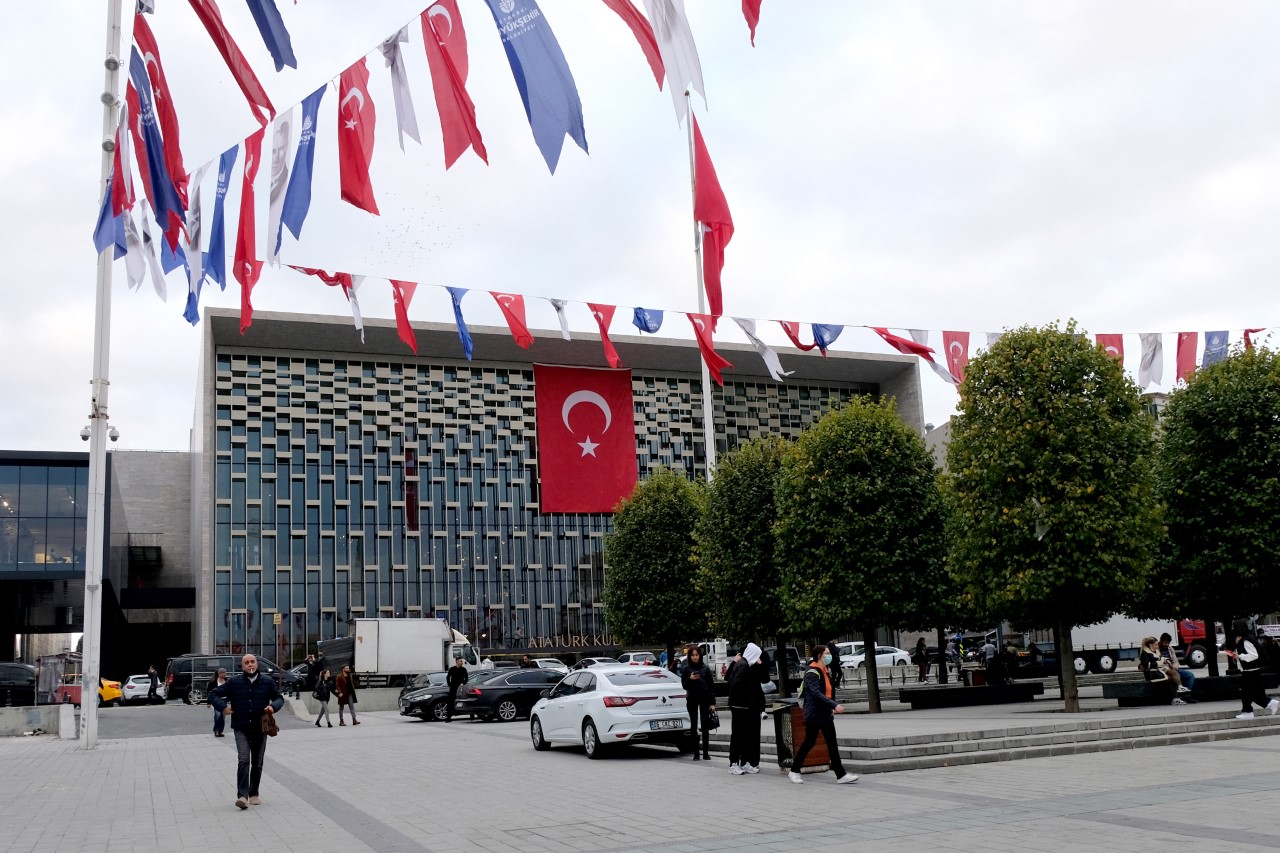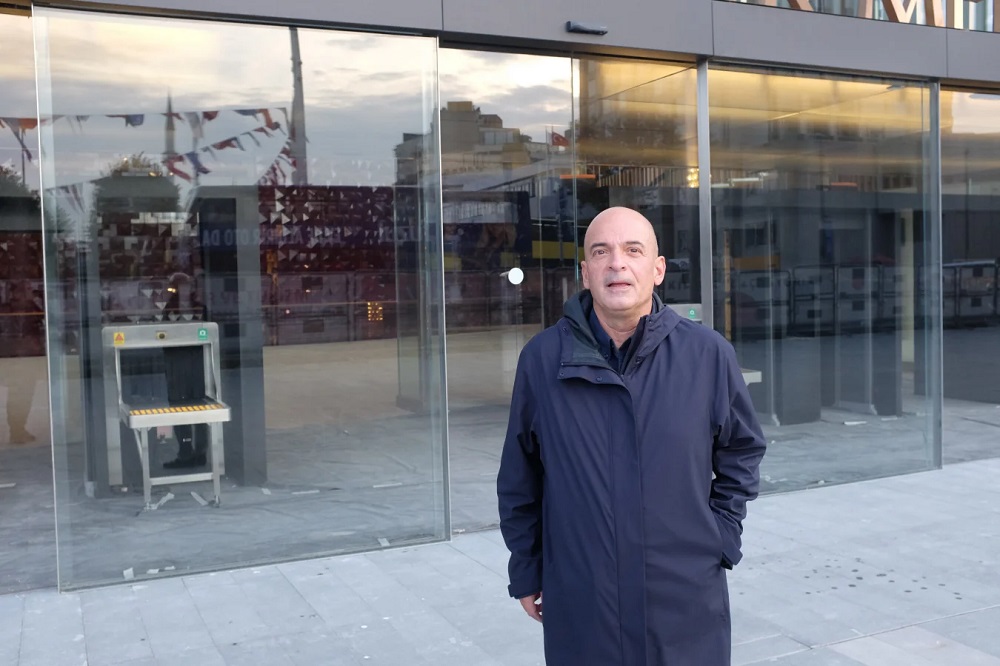Turkey's second modern age

When Istanbul-based architect Murat Tabanlioglu looks through the glass facade of the complex he designed, he sees a square, a city, a country and an idea. Tabanlioglu strides swiftly across the massive building site, checking here, correcting there, finding fault with something here, giving the all-clear on something else there. Just a few days before the new Ataturk Cultural Center opened, the massive complex on Taksim Square was almost finished. As always on such projects, it was a race against time to get everything ready.
Architects are like generals, conductors, football trainers, CEOs: they have to rally, direct, instruct and motivate their team to turn their visions into reality. Although Tabanlioglu remains calm and conspicuously polite at all times, there can be absolutely no doubt that he means business: the Ataturk Cultural Center (AKM for short in Turkish) is his project. But the AKM is more than just a building complex; it is a political and cultural symbol with a significance that radiates far beyond Istanbul.
The intention is that the new AKM on Istanbul's Taksim Square, which was opened on 29 October (Republic Day in Turkey), will become the country's cultural temple for the twenty-first century. It contains an opera house, concert hall, cinema, museum, library, galleries, archives, cafes and a terrace restaurant with the most breathtakingly beautiful view of the Bosphorus. In short, the AKM is a multi-functional palace of culture; a cosmopolitan microcosm in a city of 16 million people; an event location, meeting place, oasis of calm and pillar of the city's architectural landscape. The aim is that this temple of music will be able to hold its own at international level. The bar has certainly been set high: Oslo and Hamburg, according to Tabanlioglu.
The old Ataturk Cultural Center, which opened in 1969, burned down in 1970 and was restored. It was eventually torn down in 2018. Before demolition, the building had been completely neglected for years and was dilapidated. Those who visited it in later years spoke less of the operas they had seen and concerts they had attended there and more of the horrendous smell in its corridors. In its glory days, the old AKM was more than just an opera house and concert hall; it was a building with a mission and a symbolism that radiated far and wide.

Kemal Ataturk, Turkey's foremost root-and-branch reformer, did more than just get rid of the headscarf, the fez and Arabic script after 1923. After the fall of the Ottoman Empire in the First World War, he saw that European culture had the pull needed to direct the focus of the Turkish people westwards – away from Ottomanism, the sultanate and caliphate Islam towards the republic and the modern age. The founding myth of Ataturk's republic was built equally on a political and a cultural revolution. Moreover, the AKM was a platform for the education of the people: the building in the new functional style, the programme, the free spirit – it was all proof that Turkey had well and truly arrived in the modern age.
All of this shaped the requirements for the building that Murat Tabanlioglu was expected to meet – albeit in a very different Turkey. Recep Tayyip Erdogan has ruled Turkey for almost 20 years now. He is a conservative Islamic politician whose greatest wish seems to be to become the second Ataturk – not as a secular moderniser, but as the man who will return his country to its Islamic Ottoman roots.
A great deal of controversy surrounded the demolition of the old centre and the plans for the new one. The old AKM was part of modern Turkey's cultural heritage and its DNA. Ultimately, a new-build was permitted on condition that its facade would be a reproduction of the facade of the old building. And it is. The most striking and obvious feature of the new AKM is inside, behind the completely transparent facade: the new, U-shaped opera auditorium is made entirely of wood and seats 2,040 people. It also boasts an ultra-modern stage and a state-of-the art digital system.
It is hidden inside a massive, burgundy-coloured sphere. Covered in 15,000 shiny tiles, it puts one in mind of a ripe pomegranate. It not only fills the foyer, but it can also be seen through the glass facade from outside, from Taksim Square. Tabanlioglu's explanation of this surprising and unusual element is gratifyingly simple: "For me, red is the colour of opera."
For Tabanlioglu, who designs buildings not only in Istanbul and Turkey, but all over the world, the AKM is far more than a prestige project; it's a family matter. The old AKM was designed and built by Tabanlioglu's father, Hayati Tabanlioglu. It was the first modernist building in the country. It featured elements of the Bauhaus style, an aluminium and glass facade, free-floating staircase, wooden floors and tiled surfaces – all of which have been included by his son in the new building. "It's like a piece of classical music," says Tabanlioglu, pointing to the staircase which is based on the design of the old AKM staircase, the gently curved galleries and the bright wood. "Everyone interprets it differently. The design was fixed; the execution is new."
[embed:render:embedded:node:31402]
But the building is more than an attempt to pay homage to his father's work and to step out from beneath his shadow. Just like its demolished predecessor, the new AKM is a highly political structure. This has, among other things, much to do with its location. There is hardly anywhere that better reflects the Janus-headedness of Turkey and its domestic disunity than Taksim Square, which many called the "beating heart of the country" back in the days when it was still permissible to demonstrate regularly and with enthusiasm.
The square – a huge, plain empty space – is surrounded by a ring of impressive functional concrete buildings: hotels, banks, underground stations, etc. In the middle of Taksim Square is the Republic Monument, the high altar of Ataturk's Turkey: a massive structure of salmon-hued stone and green shimmering bronze, dominated by various images of the founder of the state. It depicts first war, then peace: Ataturk with his companions, in uniform, wearing the high fur hat; then wearing a suit and tie with a stiff collar, his pointedly visionary eyes looking straight ahead, fixed on the future. The most recent structural addition to the square is a mosque with a high dome. Directly opposite this mosque, on exactly the other side of the square, is the AKM with its red opera dome.
The new Taksim mosque was a pet project of President Erdogan. Shopping mall or airport architecture, say the critics. A building with a clear message and the power to convince those who want to be convinced, say others. For many years, Erdogan could count on getting about half of the votes cast in this 80-million-strong country. Opinion polls suggest that this support has slipped significantly in recent times.
An exercise in domestic reconciliation?
Off one side of the square, between the mosque and the AKM, is Gezi Park. The place where the protests and street battles of 2013 took place is more than just a green space in the middle of a city: this tiny park is the political home of those who stand opposed to Erdogan's vision of an Ottomanised Turkey. It must be said, however, that the Gezi generation does not cling blindly to Ataturk either. It is striving for a contemporary Turkey.
At the edge of Taksim Square, surrounded by a palisade of kebab shops and cut-price shops, corseted in as if in a straitjacket, stands the Hagia Triada, the Greek Orthodox Church of the Holy Trinity. The Hagia Triada harks back to pre-Erdogan, pre-Ataturk Istanbul: Byzantium, Constantinople, the centre of Christianity in late antiquity and the Middle Ages, and later, during the Sultanate, the capital of a multi-ethnic, multi-religious, reasonably tolerant state.
And it is here that Murat Tabanlioglu has built the new AKM: on the fault-line between Ataturk's republican modern age and Erdogan's Islam of the twenty-first century. It is not easy to build something new, while retaining the old, something that recalls both the Ottoman era and the Belle Epoque. Perhaps it would be best to see the new old AKM as what it could ideally be: a successful attempt to help Turkey reconcile become reconciled, if only a little, to itself.
© Sueddeutsche Zeitung 2021
Translated from the German by Aingeal Flanagan
